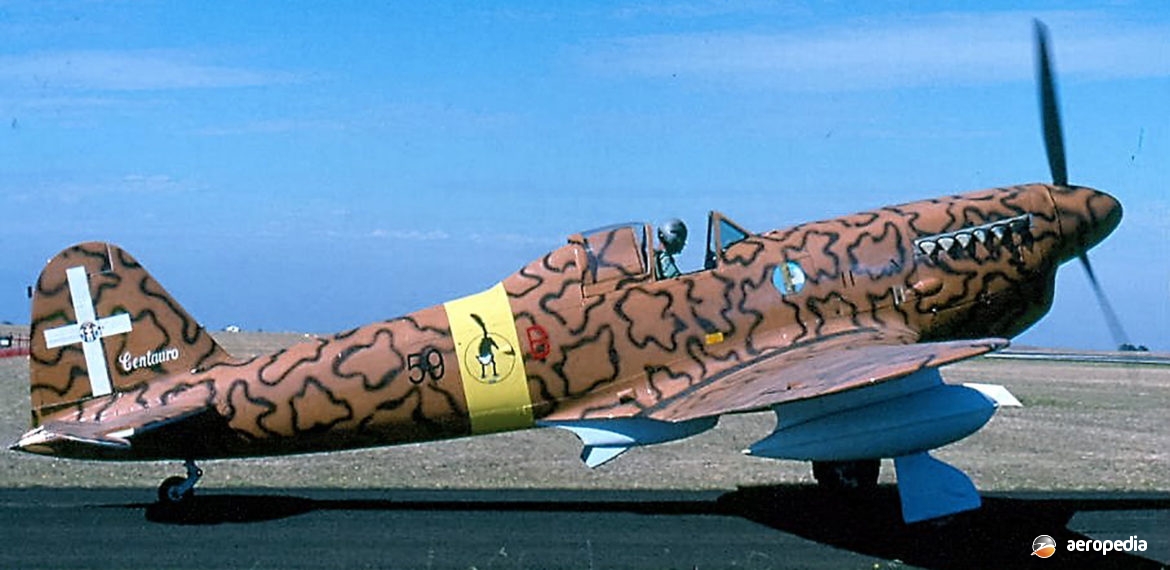Photograph:
Fiat G-59 VH-LIX (c/n MM53772) at Scone, NSW in 1998 (David C Eyre)
Country of origin:
Italy
Description:
Two-seat advanced military trainer
Power Plant:
One 1,044 kw (1,400 hp) Rolls Royce Merlin 500/20 twelve-cylinder VEE liquid-cooled engine
Specifications:
- Wingspan: 11.58 m (38 ft 10½ in)
- Length: 9.47 m (31 ft 6¾ in)
- Height: 3.68 m (12 ft 0¾ in)
- Wing area: 29.91 m² (228 sq ft)
- Max speed: 593 km/h (368 mph)
- Cruising speed: 460 km/h (286 mph)
- Climb to 7,000 m (22,965 ft): 8 mins
- Service ceiling: 11,500 m (37,750 ft)
- Range: 1,420 km (882 miles)
- Empty weight: 2,850 kg (6,283 lb)
- Loaded weight: 3,460 kg (7,628 lb)
Armament:
Two or four machine guns or cannons when used as armament trainer
History:
Late in World War II the Fiat company in Italy designed the G-55 Centauro single-seat fighter powered by the Daimler Benz DB-605 twelve-cylinder VEE liquid-cooled engine, and this aircraft, although built in relatively small numbers, fought very successfully with the Fascist Republican Air Force. After the war single and two-seat advanced trainers were developed for the Italian Air Force from the G-55, these being powered by the Fiat RA1050 engine, a licence-built DB-605.
In 1947 the prototype of a further development was first flown. Known as the Fiat G-59, it was similar to previous models but was fitted with the Rolls Royce Merlin engine. Production commenced in 1948, and a number of variants was produced to meet assorted tasks, these including: G-59-1A single-seat and G-59-1B two-seat; G-59-2A single-seat with four 20 mm wing cannon and racks for bombs or long-range fuel tanks; and the G-59-3 and G-59-4.
The G-59-1 and G-59-2 series were fitted with the 1,201 kw (1,610 hp) Rolls Royce Merlin 24 engine; and the G-59-3 and G-59-4 had the 1,044 kw (1,400 hp) Merlin 500/20 engine. The last model, the G-59-4, differed from previous models in that it had some re-design of the rear fuselage behind the cockpit to permit an all-round vision bubble-type canopy to be fitted.
Further models included the G-59-2B two-seater; G-59-3A navigation trainer; G-59-4A single-seater; and G-59-4B two-seater.
The G-59 was built in substantial numbers, the majority going to the Italian Air Force, with examples being supplied to the air forces of Syria (30), Egypt (20) and Argentina. With the advent of jet-trainer aircraft, such as the Macchi MB-326, the Fiat G-59 was eventually withdrawn from service, most being broken up.
However, at least three are known to survive, two for a period in flying condition. In 1984 the late Guido Zuccoli obtained a G-59-4B two-seat trainer which was restored to airworthiness in Chino, California, and named ‘Ciao Bella’. It was imported to Australia in 1988 after it was flown as NX59B in air-race events at Reno, Nevada. It became VH-LIX (c/n MM53772). At one stage it was rebuilt as a single-seater and camouflaged to represent a Fiat G-55AM. It was part of the Zuccoli collection at Toowoomba, QLD and was for some years regularly seen at aviation events.
A further example, also a G-59-4B, was restored to airworthiness in Italy, becoming I-MRSV (c/n MM53774), making its first post restoration flight on 25 May 1992, but having since been retired. Another has been restored and placed on display in the Italian Air Force Museum.
Another Fiat G-59-4B was noted at Precision Aerospace at Wangaratta, VIC for restoration in early 2011, this airframe being the former MM53778 with the Italian Air Force.
After the tragic loss of Mr Zuccoli in an aircraft accident, VH-LIX was placed in storage and eventually placed on the market for sale. In October 2015 it was removed from the Australian Civil Aircraft Register. It had not flown since 2009 and during an annual inspection corrosion was found on the port lower spar cap. The aircraft was inhibited until late in 2015 when it was sold to an operator in Europe which had eight new spars manufactured by Madlener in Germany and, when the aircraft arrived in Europe, the new spar caps were installed. This aircraft became I-FIAT in Italy and was flown again at Bremgarten in Germany on 22 November 2017 by Achim Meier in a bare metal scheme.

